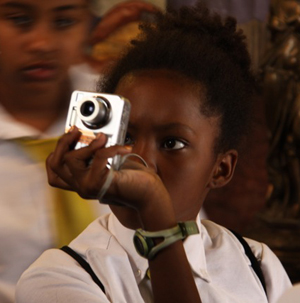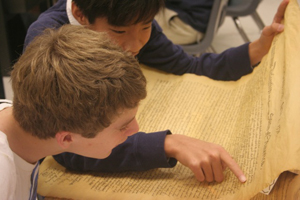 |
T A B L E O F C O N T E N T S
J A N U A R Y / F E B R U A R Y 2 0 1 6
Volume 22, Number 1/2
DOI: 10.1045/january2016-contents
ISSN: 1082-9873
E D I T O R I A L
A New Year
Editorial by Laurence Lannom, Corporation for National Research Initiatives
A R T I C L E S
Data Citation Services in the High-Energy Physics Community
Article by Patricia Herterich, CERN and Humboldt-Universität zu Berlin and Sünje Dallmeier-Tiessen, CERN
Abstract: A paradigm change in scholarly communication is underway. Supporting Open Science, an effort to make scientific research data accessible to all interested parties by openly publishing research and encouraging others to do the same thereby making it easier to communicate scientific knowledge, is a part of the change that has become increasingly important for (digital) libraries. Digital libraries are able to play a significant role in enabling Open Science by facilitating data sharing, discovery and re-use. Data citation is often mentioned as one incentive for data sharing, and therefore enabling data citation is a crucial feature of research data services. In this article we present a case study of data citation services for the High-Energy Physics (HEP) community using digital library technology. Our example shows how the concept of data citation is implemented for the complete research workflow, covering data production, publishing, citation and tracking of data reuse. We also describe challenges faced, and distil lessons learnt for infrastructure providers and scholarly communication stakeholders across disciplines.
Desktop Batch Import Workflow for Ingesting Heterogeneous Collections: A Case Study with DSpace 5
Article by Jacob L. Nash and Jonathan Wheeler, University of New Mexico
Abstract: The release of DSpace 5 has made batch importing of zipped Simple Archive Format (SAF) directories via the online user interface a possibility. This improved functionality supports a repository administrator's ability to perform batch ingest operations by removing the need to utilize the command-line, but staging large collections for ingest can be time consuming. Additionally, the SAF specification does not lend itself to an efficient desktop workflow. We describe a lightweight and easily adopted Python workflow for packaging heterogeneous collections in Simple Archive Format for batch ingest into DSpace.
Leveraging Heritrix and the Wayback Machine on a Corporate Intranet: A Case Study on Improving Corporate Archives
Article by Justin F. Brunelle, The MITRE Corporation and Old Dominion University; Krista Ferrante and Eliot Wilczek, The MITRE Corporation; Michele C. Weigle and Michael L. Nelson, Old Dominion University
Abstract: In this work, we present a case study in which we investigate using open-source, web-scale web archiving tools (i.e., Heritrix and the Wayback Machine installed on the MITRE Intranet) to automatically archive a corporate Intranet. We use this case study to outline the challenges of Intranet web archiving, identify situations in which the open source tools are not well suited for the needs of the corporate archivists, and make recommendations for future corporate archivists wishing to use such tools. We performed a crawl of 143,268 URIs (125 GB and 25 hours) to demonstrate that the crawlers are easy to set up, efficiently crawl the Intranet, and improve archive management. However, challenges exist when the Intranet contains sensitive information, areas with potential archival value require user credentials, or archival targets make extensive use of internally developed and customized web services. We elaborate on and recommend approaches for overcoming these challenges.
The Benchmarking Forum at IPRES 2015
Conference Report by Christoph Becker, University of Toronto and Vienna University of Technology; Krešimir Ðuretec, Artur Kulmukhametov and Andreas Rauber, Vienna University of Technology
Abstract: The Benchmarking Forum at the International Conference on Digital Preservation (iPres) 2015, held in Chapel Hill, North Carolina, November 2 - 6, 2015, brought together digital preservation researchers, community organizations and practitioners to discuss opportunities and challenges in adopting software benchmarking as a systematic tool for evaluating digital preservation tools. Outcomes included an initial set of benchmark specifications for targeted scenarios elaborated jointly during the workshop, and a set of concrete collaborative actions that will take place in 2016.
N E W S & E V E N T S
In Brief: Short Items of Current Awareness
In the News: Recent Press Releases and Announcements
Clips & Pointers: Documents, Deadlines, Calls for Participation
Meetings, Conferences, Workshops: Calendar of Activities Associated with Digital Libraries Research and Technologies
|
 |
F E A T U R E D D I G I T A L
C O L L E C T I O N


Teaching history with technology, through Teachinghistory.org's Digital Classroom.
[Image used with permission.]

Teaching with primary source collections using Teachinghistory.org's History Content and Teaching Materials. [Image used with permission.]
Last year, over 3 million visitors turned to Teachinghistory.org for free, quality history content, teaching strategies, best practices, and digital tools to improve U.S. history education in the classroom. Funded by the U.S. Department of Education, Teachinghistory.org is a project of the Roy Rosenzweig Center for History and New Media (RRCHNM) at George Mason University.
At the heart of Teachinghistory.org is its emphasis on developing historical thinking skills. The video "What is Historical Thinking?" provides an introduction to core historical thinking strategies such as close reading, sourcing, and contextualization. A Historical Thinking poster can be downloaded. There are videos of historians, curators, and archivists modeling Examples of Historical Thinking with a range of primary sources such as songs, political cartoons, photographs, or letters.
Teachinghistory.org's Website Reviews can be searched for more than 1,100 websites related to American history by keyword, topic, time period, or resource type. History in Multimedia enables finding free multimedia content such as lectures, documentaries, podcasts, or dramatic readings.
Teachinghistory.org also offers ways to question the standard textbook narrative. What textbooks, historians, and sources have to say on topics as varied as immigration, women's rights, or the causes of the Civil War can be compared using resources found in Beyond the Textbook.
For those looking for teaching ideas, Lesson Plan Reviews can be searched by keyword, grade level, or topic to find lessons that model ways to incorporate different aspects of historical thinking skills in the classroom. Lessons range from the fact and fiction behind Paul Revere's ride to exploring tenement life at the turn of the 20th century.
English Language Learners collects research from the field about language development and acquisition, as well as links to teaching strategies, lesson ideas, and websites with primary sources written in multiple languages. Teaching Guides offer practical classroom ideas, searchable by keyword and grade level. Written by experienced educators, each guide includes instructions and downloadable PDFs to help implement teaching strategies immediately.
Beyond the Chalkboard and Tech for Teachers provide examples of educators modeling lessons that effectively employ digital tools such as Skype, microbloggin, and interactive whiteboards. These technologies can enable students to connect with experts, collaborate with each other, and allow teachers to individualize instruction to meet student needs.
In an independent survey of Teachinghistory.org users, 98% of users found the information they were seeking and 88% said they were very or extremely likely to recommend Teachinghistory.org to a friend. With its emphasis on quality history content and teaching methods, Teachinghistory.org is helping educators everywhere improve their practice, learn new ideas, and connect with the larger historical community.
D - L I B E D I T O R I A L S T A F F
Laurence Lannom, Editor-in-Chief
Allison Powell, Associate Editor
Catherine Rey, Managing Editor
Bonita Wilson, Contributing Editor
|